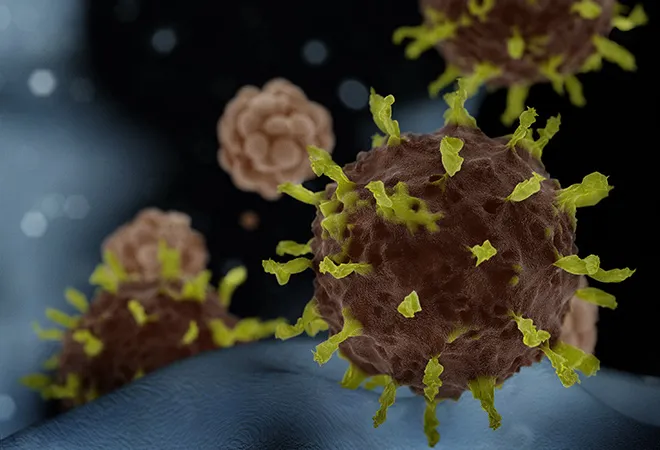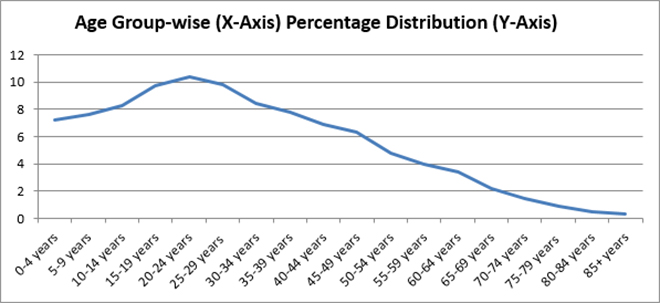
The recent Coronavirus disaster brings to the fore the importance of India’s preparedness in dealing with such catastrophic times - given its high urban population density, lack of hygiene & sanitation facilities and most importantly, inadequate treatment capacity. The UN Sustainable Development Goal 3 (Good Health and Well-Being) outlines the 2030 global targets in terms of upgrading healthcare infrastructure and access to medical facilities, that lies at the heart of human capital enhancement of nations. According to the Sustainable Development Solutions Network Report 2019, India scores as low as 58.8 (out of 100) in comparison to the other developed nations, based on SDG 3. This is a much lower score compared to the COVID-19 originating country China, which scores 81.1 (out of 100) and has recorded the highest number of reported cases and deaths worldwide due to COVID-19. The comparative statistics raise serious apprehensions on how the Coronavirus disaster can be contained in India with its lower levels of healthcare preparedness.
As widely notified, the next two weeks will be crucial for India's fight against this pandemic where the country's fate will be decided depending upon its ability to avert the exponential rise of the infectious disease. West Bengal is one of the few states that did not have a single case of Coronavirus infection until March 17th, 2020 after which it reported a single case on the same evening. Although West Bengal's basic health indicators are not on the lower end compared to the other Indian states, it is lagging behind Kerala and Maharashtra on all the health parameters (see table below), according to the Government’s latest available statistics. As evidenced by the uncontrollable rise of COVID-19 positive patients in Kerala and Maharashtra due to lack of medical screening and precautionary tests, these parameters on health facilities hint that the current healthcare infrastructure in West Bengal may also fail, and in fact in a worse manner. Against this background, it is all the more important for this region to step up its preventive measures against this deadly virus.
Table: Basic Health Indicators in West Bengal
| Indicator |
West Bengal |
India Average |
Major states better than West Bengal |
| Birth rate, 2015 |
15.5 |
20.8 |
Kerala (14.8), Tamil Nadu (15.2), Punjab(15.2) |
| Death rate, 2015 |
5.9 |
6.5 |
Delhi (3.6), Jammu & Kashmir (4.9), Jharkhand (5.8), Maharashtra (5.8) |
| Infant mortality rate, 2015 |
26 |
37 |
Kerala (12), Delhi (18), Tamil Nadu (19), Maharashtra (21), Punjab (23) |
| Total fertility rate, 2015 |
1.6 |
2.3 |
Lowest in West Bengal. Kerala (1.8), Maharashtra (1.8). |
| Neonatal mortality rate, 2015 |
18 |
25 |
Kerala (6), Punjab (13),Tamil Nadu (14), Telangana (14), Delhi (14), Maharashtra (15) |
| Under 5 mortality rate, 2015 |
30 |
43 |
Kerala (13), Delhi (20), Tamil Nadu (20), Maharashtra (24), Punjab (27), Jammu & Kashmir (28) |
| Maternal mortality ratio, 2011-13 |
113 |
167 |
Kerala (61), Maharashtra (68), Tamil Nadu (79), Andhra Pradesh (92), Gujrat (112) |
Source: Department of Health & Family Welfare, Government of West Bengal & NITI Aayog
There are mainly two reasons why West Bengal and the Northeast Indian region are more vulnerable to contagious diseases like this – Firstly, this region shares a number of international land borders with Coronavirus infected countries like China, Myanmar, Nepal, and Bhutan. Although the cases in Nepal and Bhutan are comparatively much lower than other countries, they have a dominant tourism sector that finds Kolkata airport as a transit route for a large number of tourists from the infected South and Southeast Asian countries. Although the borders are under tight control at the moment, the uncertainty of already existing unreported cases looms large in Eastern India. The disputed border control in this region finds even more importance in these times in order to contain this fatal viral disease.
Secondly, as per the last Census in 2011, an estimated 220 thousand people have migrated from West Bengal to other states in search of work and these estimates have exponentially grown over the last decade. West Bengal ranks 4th in terms of outbound migrant labourers, (after the states of Uttar Pradesh, Bihar, and Rajasthan) especially from the districts of Malda, Burdwan, Nadia, Hooghly, and Murshidabad. The fact that a large majority of these migrants are seasonal laborers and their most preferred destinations are Maharashtra, Delhi, Kerala and Karnataka (the most intensely infected states in India) – poses a serious threat of COVID-19 transmission given the uncontrolled return of these migrants to West Bengal induced by this panic situation.
According to the Chinese data, COVID-19 fatality rates increase with age and the age group beyond 80 years old is the most vulnerable one. On an optimistic note, the estimated population data (2017) shows that the percentage of population beyond the age of 80 years is statistically much less in the overall age group-wise demography of West Bengal (see figure below) – hence the healthcare facilities should be in a position to give priority to this small segment of the dependent population.
Figure: Age Group-wise Percentage Distribution of Estimated Population in West Bengal, 2017
 Source: Author’s own. Data from the Office of the Registrar General and Census Commissioner, Ministry of Home Affairs, Government of India
Source: Author’s own. Data from the Office of the Registrar General and Census Commissioner, Ministry of Home Affairs, Government of India
On Monday, 16th March 2020, the Government of West Bengal invoked the 123-year-old Epidemic Diseases Act 1897 to prevent COVID-19 infections in the state following instructions from the Cabinet Secretary of India. As the country prepares for this emergency, the West Bengal Government too exercises measures of ‘social distancing’ by shutting down educational institutions, auditoriums, movie halls, clubs, and religious places. Additionally, the state has also created a 200-crore fund towards COVID-19 prevention and has also deferred the various Municipal Corporation Elections, including the Kolkata Municipal Corporation (KMC) Election that was slated to be held in April this year. It is now for time to tell if this region can insulate itself from this pandemic and how India can get back on track by curbing the Coronavirus spread in the next few weeks.
The views expressed above belong to the author(s). ORF research and analyses now available on Telegram! Click here to access our curated content — blogs, longforms and interviews.




 Source: Author’s own. Data from the
Source: Author’s own. Data from the  PREV
PREV


